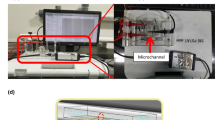Abstract
Presently, microfluidic heterogeneous immunoadsorption (MHI) has been regarded as an effective and efficient on-chip sample preparation method for various clinical diagnoses. In this work, adsorption performances of an electroosmosis flow (EOF)-based competitive MHI under saturated status are studied numerically. Along with the well-known flow and surface reaction control modes, the diffusion control mode specified in the fluidic configuration is scrutinized to characterize the MHI performance. The numerical results indicate that only in the surface reaction or the diffusion control mode can saturated EOF-based MHI obtain a linear dose–response along with a perfect assay signal without so-called dissociative antigen noise. Considering the tunable assay time and realizable flow velocity required by chip applications, the diffusion controlled MHI is recommended in this work.






Similar content being viewed by others
Notes
\(CET/CSRT = - 1n\left( {1 - 0 \cdot 99} \right) = 4 \cdot 6\)
References
T.P. Burg, A.R. Mirza, N. Milovic, C.H. Tsau, G.A. Popescu, J.S. Foster, S.R. Manalis, J. Microelectromech. Syst. 6, 1466–1476 (2006)
A. Dodge, K. Fluri, E. Verpoorte, N.F. de Rooij, Anal. Chem. 73, 3400–3409 (2001)
E. Eteshola, M. Balberg, Biomed. Microdevice 6, 7–9 (2004)
E. Eteshola, D. Leckband, Sens. Actuators B 72, 129–133 (2001)
V.I. Furdui, D.J. Harrison, Lab Chip 4, 614–618 (2004)
G. Hu, Y. Gao, P.M. Sherman, D. Li, Microfluidic Nanofluidic 1, 346–355 (2005)
M. Kohmoto, M. Enomoto, A. Tamori, D. Habu, T. Takeda, N. Kawada, H. Sakaguchi, S. Seki, S. Shiomi, S. Nishiguchi, J. Med. Virol. 75, 235–239 (2005)
V. Linder, E. Verpoorte, N.F. de Rooij, H. Sigrist, W. Thormann, Electrophoresis 23, 740–749 (2002)
A. Lionello, J. Josserand, H. Jensen, H.H. Girault, Lab Chip 5, 1096–1103 (2005)
L.E. Locascio, J.S. Hong, M. Gaitan, Electrophoresis 23, 799–804 (2002)
J.D. Murray, Mathematical Biology (Springer, Berlin, 1993), pp. 175–217
P. Neofytou, Biorheology 41, 693–714 (2004)
T.M. Squires, S.R. Quake, Rev. Mod. Phys. 77, 77–1026 (2005)
W.Q. Tao, Numerical Heat Transfer (Xian Jiaotong University Press, Xian, 2001), pp. 78–186
D. Wang, D. Jiang, C. Yuan, Colloid Surf. A 175, 129–134 (2000)
J. Yakovleva, R. Davidsson, A. Lobanova, M. Bengtsson, S. Eremin, T. Laurell, J. Emneus, Anal. Chem. 74, 2994–3004 (2002)
T. Yang, S.Y. Jung, H. Mao, P.S. Cremer, Anal. Chem. 73, 165–169 (2001)
M. Zimmermann, E. Delamarche, M. Wolf, P. Hunziker, Biomed. Microdevice 7, 99–110 (2005)
Acknowledgements
The project is financially supported by the National Natural Science Foundation of China (Grant No. 60576020 and No. 60606014). Wei Wang would also like to thank the financial support of the China Postdoctoral Science Foundation.
Author information
Authors and Affiliations
Corresponding author
Appendix
Appendix
1.1 Derivation of α
In this paper, a simplified model is used to calculate the ratio of the amount of analyte that reacts on the channel surface to the total amount injected from the inlet (i.e. α) in the MHI. As the immunoreaction on the surface is usually very fast in the diffusion controlled MHI, concentration of the analyte on the surface in the whole microchannel is assumed to be zero. Therefore, the complicated convection–diffusion–reaction system can be simplified as a transient diffusion process,
with a constant-value boundary condition,
The solution of Eq. 10 is,
When the analyte flows out of the microchannel, the profile of [A] along the height of the channel is thereby written as,
Therefore, the proportion of analytes consumed on the channel surface in the reaction region, i.e. α, can be calculated as,
In most cases, the first term of this series function is enough to calculate α accurately, so a very simple form of α is obtained as,
Rights and permissions
About this article
Cite this article
Zhao, S., Wang, W. & Li, Z. Linearity and dissociative antigen noise analyses of competitive microfluidic heterogeneous immunoadsorption. Biomed Microdevices 10, 519–529 (2008). https://doi.org/10.1007/s10544-007-9161-4
Published:
Issue Date:
DOI: https://doi.org/10.1007/s10544-007-9161-4




